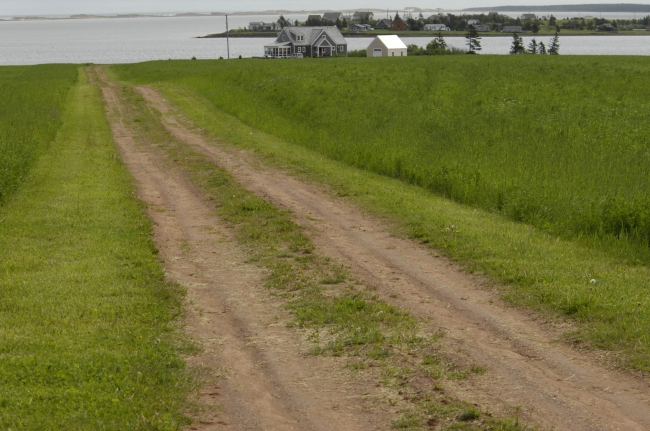PEI’s Progress On The Nitrate Challenge
Published on by Diana Tyner (M.Sc.), Environmental Advisor, Blogger
PEI's Progress On The NitrateChallenge
Recently I took my first trip to the "garden of the gulf" - Canada's smallest and yet one of our most beautiful Provinces, Prince Edward Island. As a non-islander I was expecting a few clichés…the red Charlottetown soil series, Green Gables, and of course lots of potatoes and farming. But what really fascinated me was the amount of water held within the land - something I wasn't expecting. It was really water water everywhere.
Driving through the interior of the Province it seemed everywhere you turned there was more and more water - a river, a creek, a tributary, a wet yes land. Wet-lands they are referred to as. Most of the water seemed to be draining from many sources into the Charlottetown harbour area. From my snapshots of surface water sources, it made me imagine the amount of ground water flowing underground. Sometimes it's hard to imagine as water dries up on the surface or as a stream flows into karst topography how much water is underground? Just because we don't see it, it doesn't mean its not flowing underground. So why my concern?
The Island Nitrate Challenge
Human health concerns surfaced in PEI surrounding the island's nitrate challenge for about the last decade, and in 2008 these concerns triggered a commissioned report summarizing the quality of PEI drinking water. For you non-islanders, PEI receives 100% of their drinking water from ground water sources and is probably the only Canadian Province dependent solely on groundwater supplies.
The water quality specialist in me would argue nitrates are not just a human health concern but also an environmental and aquatic health concern impacting fisheries and PEI's well being to say the least.
Commissioned Report Findings
Results of the report confirmed and cite that "the tests conducted at a series of free nitrate drinking water clinics have revealed that in 2007, six per cent of private wells exceeded the 10 mg/L guideline, and an alarming 11 per cent tested between eight and 10 mg/L."
"Nitrate levels were seen by many as being dangerously high, at all-time high in both surface and groundwater, and while much has been made of the potential hazards of increased nitrates in our drinking water, almost nothing has been done to reverse the problem."
The report also recognized two main basic principles worth noting:
1. The present state of nitrates in the Island's surface and groundwater did not occur overnight; the solution also will be long-term.
2. All Islanders have contributed to the problem; all must participate in the solution.
Why Are Nitrates A Challenge in PEI?
Nitrates in drinking water can be a health hazard when present at relatively high concentrations (over 10 ppm). At much lower concentrations, nitrate interacts with other pollutants including trace mixtures of pesticides and they can produce health concerns. Some areas in PEI have reached 10 or more ppm. Canadians have the capacity to drill deeper wells in order to reach less contaminated water, which has opened another can of worms lately in which I will refrain from delving into. Wildlife are entirely dependent on surface water, which is more likely to be contaminated, and at higher concentrations. Eek, what about those poor shellfish?
What's Happened Since 2008?
What has happened since the commissioned report findings were published? More than five years have passed since the commissioned report findings were published along with recommendations. Excess nitrates from fertilizer use in agriculture, was one of the leading culprits for increases in nitrate concentrations.
And as Marq de Villes quote suggests, "we can know what's going on, and we can fix what's gone wrong, that's the point of all of it."
So what have we learned and accomplished in five years? In 2012 the Province of PEI, and the Canadian Fertilizer Institute, the PEI Potato Board, PEI's Federation of Agriculture, and Kensington North Watershed Associationsigned a memorandum of understanding supporting and adopting 4R nutrient stewardship on the Island it was the beginning of Farming 4R Island as we know it. More information on this initiative can be found at:http://www.farming4rfuture.ca/en/farming-4r-drinking-water/
The Big Questions
There still remain a number of big questions that need to be answered: How much change has occurred since 2008? How can more be achieved and what will be the drivers of change? How can we positively change the perception of farming in PEI? How many farmers are contributing or adopting in Farming 4R Island? What are the barriers for adopting Farming 4R Island? What are the successes?
Instead of point fingers on the negatives about farming in PEI lets talk about some of the positives - the Farming 4R Island initiative has began, farmers are rotating cropping systems each year, manure management guidelines keep manure management under check, etc. PEI and PEI farmers are addingvalue in agriculture for the future and all are working collectively towards cleaner drinking water sources now and for the future. So on this Canada Day - a big shoutout to the PEI farmers for a job well done in the right direction!
Otherwise let's continue this discussion in the Farming 4R Future web-group - What are your thoughts on this issue?http://www.linkedin.com/groups?home=&gid=4663992&trk=my_groups-tile-grp
--------------------------------------------------------------------------------------------------------------------------------------------------------
Diana Tyner (M.Sc.)is an environmental advisor, water guru, and certified CSA greenhouse gas quantifier. She works with Canadian business, government, and non-profits to advance, science, agriculture, and economics.Read more blog post from Dianahere

